This article was co-authored by Carrie Noriega, MD. Dr. Noriega is a Board Certified Obstetrician & Gynecologist and medical writer in Colorado. She specializes in women’s health, rheumatology, pulmonology, infectious disease, and gastroenterology. She received her MD from the Creighton School of Medicine in Omaha, Nebraska and completed her residency at the University of Missouri - Kansas City in 2005.
There are 10 references cited in this article, which can be found at the bottom of the page.
wikiHow marks an article as reader-approved once it receives enough positive feedback. In this case, 91% of readers who voted found the article helpful, earning it our reader-approved status.
This article has been viewed 430,595 times.
Clomid, also known as clomiphene citrate, is an FDA-approved drug that has been used to induce ovulation, or egg production, in women for more than 40 years. If you have infertility problems and problems getting pregnant stemming from anovulation, which is a lack of ovulation, Clomid may be a viable option for you.[1] Talk with your doctor to understand how Clomid is used to see if it is right for your situation.
Steps
Preparing to Take Clomid for Infertility
-
1Get a fertility workup. Before you take Clomid, you need to ensure that you need the drug at all. As it is only available via prescription, you should visit your gynecologist or fertility specialist to have a complete fertility workup. Infertility can result from numerous different causes. It is important to determine the cause of your infertility in order to ensure proper treatment.
- Most likely, your doctor will recommend your partner have a fertility workup done as well.[2]
-
2Discuss your options with your doctor. If your doctor decides that your problem is anovulation and prescribes you Clomid, discuss the protocol she is using for your case. Your protocol may include different things such as a trigger medication for your ovulation. The protocol will also include the introduction of sperm, which can be through natural intercourse or intrauterine insemination (IUI). IUI is when the doctor places the sperm into the uterus to help ensure that it is in the right place.[3]
- The doctor will also schedule multiple appointments for blood work or ultrasounds to continue to check your health and the state of your reproductive organs.
Advertisement -
3Contact your doctor the first day of your cycle. Before each of your treatments, you will need to check in with your doctor at the beginning of your period to ensure that you are still healthy. Usually, you can check in with your doctor via a phone consultation.
- If you do not have a period of your own, your doctor may prescribe progesterone to induce it.
- It is important to contact your doctor early because she may need a baseline ultrasound to check for cysts before starting your treatment cycle.
- This process may continue throughout your treatment because cysts may have developed as a result of your last Clomid cycle.[4]
Taking Clomid for Infertility
-
1Start Clomid. Once your doctor has checked to make sure everything is fine, she will start administering your treatments. You will generally be asked to take Clomid starting on day 3 to 5 of your cycle and continue to take it at the same time every day for 5 days. You will likely be started on a low dose of Clomid, such as 50 mg a day. This is to reduce the likelihood of developing cysts, side effects, and multiple pregnancies.
- If you do not become pregnant, your doctor may increase the amount that you should take during the next cycle.[5]
- Make sure you take your medication for the required 5 days without skipping a day. If you have a hard time remembering to take medications, leave yourself a note somewhere that you will see it or set a reminder in your phone to take it at the same time every day.
- If you miss a dose, take the missed dose as soon as you remember it. However, if it is almost time for the next dose, call your doctor for directions. Do not take a double dose.
-
2Create a schedule. There are a lot of actions that go into fertility treatments with Clomid. Since it can get overwhelming, you should make a schedule or calendar of the days you need to take your medication as well as all the different activities, tests, and cycles you need to keep up with. The doctor will give you all the information you need to put on your calendar. You should mark your cycle days, starting with day 1 as the first day of your period.
- You should then add the days you will be taking Clomid, days you will have intercourse, day you need to take a trigger medication, any IUI date, and all dates you have blood work or ultrasounds scheduled.[6]
-
3Keep all your appointments. You will likely be closely monitored during your treatment cycle. Your doctor will check to make sure you are responding to Clomid appropriately. She will do this either by checking your estrogen levels or giving you an ultrasound to determine if you have egg growth.
- Alternatively, your doctor may ask you to track your response to the medication by using home ovulation predictor kits. Keep your doctor informed of the results.
-
4Learn what the drug is doing. After the first round of treatment, you may wonder what exactly the drug is doing for you. In response to hormonal changes brought on by Clomid, you should develop follicles in your ovaries that contain eggs. Typically, one of these follicles will become the dominant follicle and its egg will reach maturity, indicating it is ready to be released and you are ready for ovulation to occur.
- If you are not responding to the Clomid and your follicle is not developing properly, your treatment cycle may get cancelled. With your next cycle, your doctor may increase the dose of Clomid.
-
5Monitor your ovulation. Around 12 days into your cycle, you will need to start checking for ovulation, which is the time for you to get pregnant. Ovulation can occur at different times for each person, but most often it is on the 16th or 17th day of your cycle. To be more precise, however, your doctor will want to monitor your ovulation in a few different ways.
- Your doctor may ask you to take your body temperature every morning at the same time. If your temperature rises about 0.5 degrees fahrenheit, it may indicate that your ovulation has occurred in the last 12 to 24 hours.
- Your doctor may also recommend using an ovulation predictor. These are available over the counter in pharmacies. It looks similar to urine pregnancy test; however, it checks for a hormone called luteinizing hormone (LH). Your LH is highest about 24-48 hours before you ovulate and you are most fertile the day of your LH surge and the two days after.
- Instead of an ovulation predictor, your doctor may use ultrasounds to check if your egg is mature or if you have ovulated.
- Your doctor may also measure your progesterone levels about 14 to 18 days after starting Clomid. An increase in progesterone may indicate ovulation has occurred and indicate the viability of pregnancy.[7]
-
6Trigger your ovulation. If you cannot get yourself to ovulate (or instead of waiting for ovulation to occur), the doctor may prescribe a trigger medication such as Ovidrel. This is a human chorionic gonadotropin that acts just like LH. This medication will cause your egg to release, which makes ovulation occur.
- Once you take the injection, it is estimated that you will ovulate about 24-48 hours.
- If your protocol includes IUI, it will generally be scheduled about 36 hours after taking your trigger shot.[8]
-
7Have intercourse on the days your doctor advises. Once you start treatment with Clomid, you need to make sure you take advantage of as many opportunities to get pregnant as you can. This means you need to have intercourse whenever your doctor advises you to have it. These days will occur on certain days around your predicted ovulation day.
- If your ovulation is triggered, your doctor will give you the days you need to have intercourse to give you the best chance at getting pregnant.[9]
-
8Check to see if your treatment was successful. Once you have completed a treatment of Clomid, you need to see if it worked. During ovulation when your egg is released, you hopefully were able to have it fertilized by the sperm. If this happened, the embryo will reach and implant into the uterus several days later.
- If you have not gotten your period about 15 days after your LH surge, your doctor will ask you to come in for a pregnancy test.
- If you are pregnant, you will not need Clomid treatments anymore.
-
9Try again. If you were not successful the first month, don't lose hope. You can continue with Clomid the next month. If you do not get pregnant, you will usually start your period 14 to 17 days after ovulation.[10] The first day you start will be day 1 of your next cycle and your doctor will proceed with the next treatment cycle.
- She may increase your dose of Clomid or suggest another treatment altogether.
- In general, it is not recommended that you take Clomid for more than 6 cycles.[11] If you have still not become pregnant after 3 or 6 cycles, discuss further options with your physician.
Understanding Clomid
-
1Learn how it works. Clomid is classified as an ovulatory stimulant used by women with fertility problems. It works by binding to the estrogen receptors in your body, blocking them from producing, and causing your body to think you have low estrogen. This in turn causes your body to release the gonadotropin-releasing hormone (GnRH). This reproductive hormone causes the your body to produce more follicle-stimulating hormone (FSH), which helps encourage egg production in the body.
- FSH stimulates the development of the follicles, which are the elements that contain the eggs in your ovaries.[12]
-
2Know when to use it. A doctor may prescribe you Clomid for a few different reasons. Clomid is used when you have an infertility condition in which you cannot ovulate, which means you cannot produce or release a mature egg. Indications that you may have issues with ovulation include absence of your period or having irregular periods.
- One common condition Clomid is used for is polycystic ovarian syndrome (PCOS). PCOS symptoms include irregular periods, excess facial and body hair, acne, and male pattern baldness. This condition can also cause cysts on your ovaries. There are different medications used to treat the symptoms of PCOS, but Clomid is used as first line treatment for infertility resulting from PCOS.[13]
- Do not use if you are pregnant. Generally, your doctor will do a pregnancy test before prescribing Clomid.
-
3Take the correct dosage. Your doctor should advise you about which concentrations of Clomid to use. However, in most cases, the starting dose is 50 mg by mouth daily for 5 days, starting on the 5th day of your cycle. If that does not induce ovulation, the dose may be increased to 100 mg by mouth daily for 5 days on the next cycle.
- The treatment can change from one cycle to the next, especially if there is no increase in ovulation.
- Do not increase or decrease dosage on your own. Make sure you always follow your doctor's instructions about dosage.[14]
-
4Recognize the side effects. There are a few common side effects of Clomid. It may cause some common mild side effects such as flushing or an overall feeling of warmth, upset stomach including nausea and vomiting, breast tenderness, headache, dizziness, abnormal vaginal bleeding, and blurry vision.
- This medication may cause ovarian hyperstimulation syndrome (OHSS), which can occur during or after treatment. OHSS, while serious, is rare. OHSS may cause serious and dangerous issues such as fluid build up in the abdomen and chest. Get medical help right away if you develop severe pain or swelling, rapid weight gain, nausea, or vomiting.[15]
- If you have severe vision issues, swelling of your abdomen or shortness of breath contact your doctor right away.[16] [17]
-
5Understand the risks. Although Clomid can help with ovulation, you have to be careful with the medication. Clomid should not be used for more than six cycles. If you have used Clomid for 6 cycles and have not become pregnant, your doctor may recommend other options such as hormone injections or in vitro fertilization (IVF).
- Ovarian cysts may form from ovarian overstimulation. An ultrasound may be performed to look for ovarian cysts before beginning another Clomid treatment cycle.
- Long-term use of clomiphene, the medicine in Clomid, may increase the risk of ovarian cancer, but there are some recent studies that do not support this.[18]
References
- ↑ http://www.mayoclinic.org/drugs-supplements/clomiphene-oral-route/description/drg-20063072
- ↑ http://www.babymed.com/fertility-problems/making-clomiphene-clomid-work-you
- ↑ http://www.drugs.com/clomid.html
- ↑ http://www.advancedfertility.com/clomid-treatment.htm
- ↑ http://www.mayoclinic.org/drugs-supplements/clomiphene-oral-route/proper-use/drg-20063072
- ↑ http://www.advancedfertility.com/clomid-treatment.htm
- ↑ http://www.glowm.com/section_view/heading/Induction%20of%20Ovulation%20with%20Clomiphene%20Citrate/item/336#2273
- ↑ http://www.glowm.com/section_view/heading/Induction%20of%20Ovulation%20with%20Clomiphene%20Citrate/item/336#2273
- ↑ http://www.drugs.com/clomid.html
- ↑ http://www.glowm.com/section_view/heading/Induction%20of%20Ovulation%20with%20Clomiphene%20Citrate/item/336#2273
- ↑ http://www.glowm.com/section_view/heading/Induction%20of%20Ovulation%20with%20Clomiphene%20Citrate/item/336#2273
- ↑ http://www.glowm.com/section_view/heading/Induction%20of%20Ovulation%20with%20Clomiphene%20Citrate/item/336#2273
- ↑ http://www.ncbi.nlm.nih.gov/pubmed/24151290
- ↑ http://reference.medscape.com/drug/clomid-serophene-clomiphene-342752#0
- ↑ http://reference.medscape.com/drug/clomid-serophene-clomiphene-342752#5
- ↑ http://www.nlm.nih.gov/medlineplus/druginfo/meds/a682704.html
- ↑ http://reference.medscape.com/drug/clomid-serophene-clomiphene-342752#5
- ↑ http://www.glowm.com/section_view/heading/Induction%20of%20Ovulation%20with%20Clomiphene%20Citrate/item/336#2273
About This Article
To take Clomid, which is used to treat infertility in women, you should first visit your gynecologist or fertility specialist to make sure the drug is right for you. Once your doctor has prescribed you with Clomid, follow their directions for taking the drug. You'll probably need to start taking it on the third day of your cycle and continue taking it at the same time every day for 5 days. It may help you to create a schedule of when you should take the drug and any other activities and tests your doctor advises to help you keep track of everything. Attend all of your doctor appointments, like checkups and ultrasounds, to monitor your progress. Around the 12th day of your cycle, you should start checking for ovulation by taking your temperature or using an ovulation predictor as directed by your doctor. You should have intercourse during ovulation to take advantage of as many opportunities to get pregnant as you can. If you don’t get pregnant the first month, try not to worry, since you can keep trying. For more tips from our Medical co-author, including how to recognize common side effects of Clomid, read on!

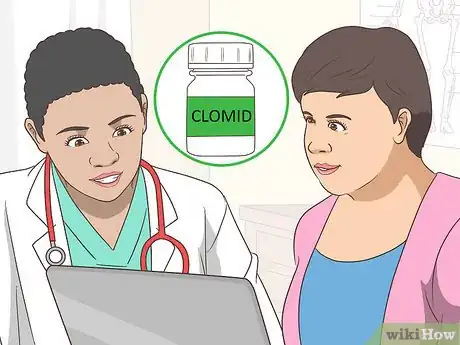

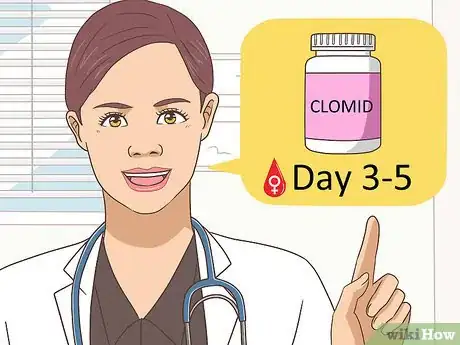
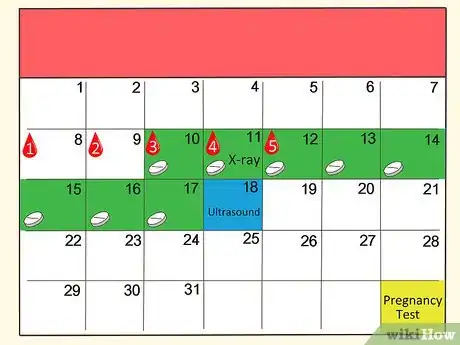

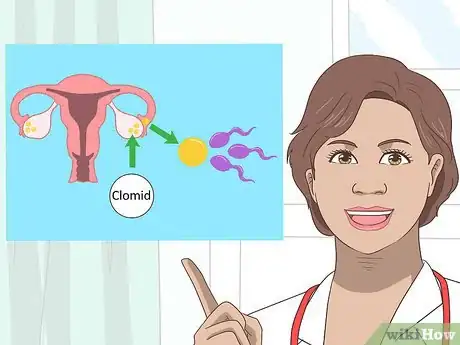
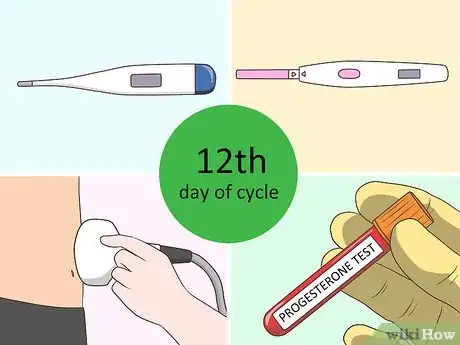
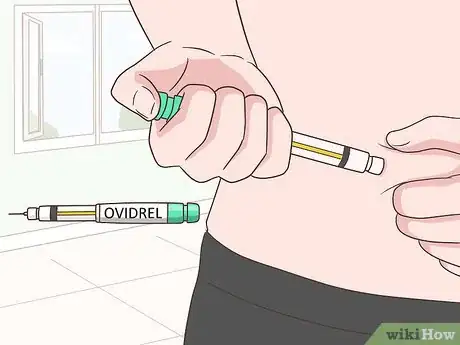

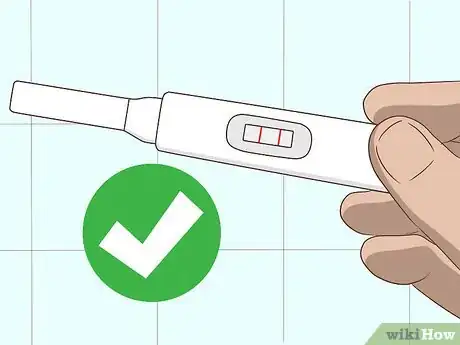
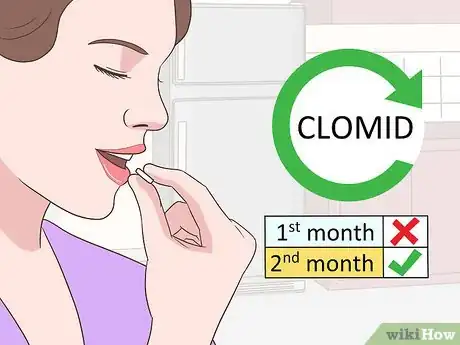



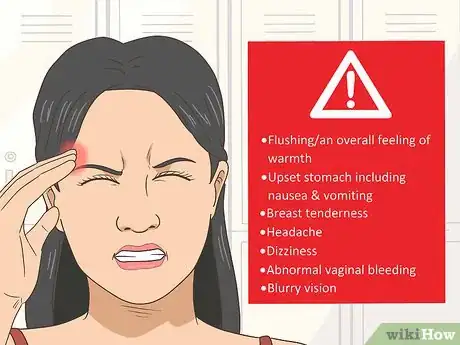





























































Medical Disclaimer
The content of this article is not intended to be a substitute for professional medical advice, examination, diagnosis, or treatment. You should always contact your doctor or other qualified healthcare professional before starting, changing, or stopping any kind of health treatment.
Read More...